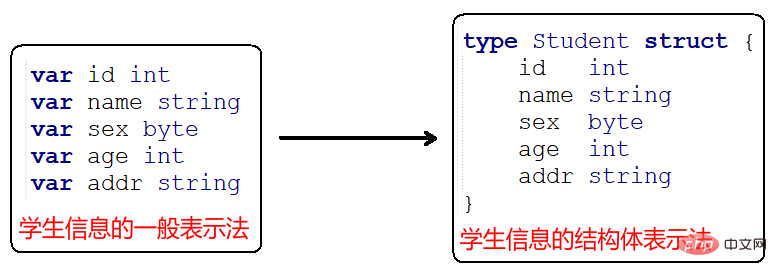
In the Go language, a structure is a composite type with members in the type; it is an aggregate data type, a data collection composed of a series of data of the same type or different types, each The data are called members of the structure. Structure members are composed of a series of member variables, which are also called "fields". Characteristics of fields: 1. The field has its own type and value; 2. The field name must be unique; 3. The type of the field can also be a structure, or even the type of the structure in which the field is located.

The operating environment of this tutorial: Windows 7 system, GO version 1.18, Dell G3 computer.
What is a Go language structure?
Go language forms new types in a customized way. Structures are types with Composite type of members. The Go language uses structures and structure members to describe real-world entities and various attributes corresponding to the entities.
Structure is an aggregate data type, which is a data collection composed of a series of data of the same type or different types. Each piece of data is called a member of the structure.

Structure members are composed of a series of member variables, which are also called "fields". Fields have the following characteristics:
Fields have their own types and values.
Field names must be unique.
The type of a field can also be a structure, or even the type of the structure in which the field is located.
Go language structure definition
Go language can form new types and structures in a customized way It is a composite type among these types. A structure is an entity aggregated from zero or more values of any type. Each value can be called a member of the structure.
Use the keyword type to define various basic types as custom types. Basic types include integers, strings, Boolean, etc. The structure is a composite basic type. Defining it as a custom type through type makes the structure easier to use.
The definition format of the structure is as follows:
type 类型名 struct {
字段1 字段1类型
字段2 字段2类型
…
}Explanation of each part:
Type name: identifies the name of the custom structure, in Cannot be repeated in the same package.
#struct{}: Indicates the structure type. The type type name struct{} can be understood as the type that defines the struct{} structure as the type name.
Field 1, Field 2...: Indicates the field names of the structure. The field names in the structure must be unique.
Field 1 type, field 2 type...: Indicates the type of each field of the structure.
Use a structure to represent a point structure containing X and Y integer components. The code is as follows:
type Point struct {
X int
Y int
}Same type of variables can also be written in one line, color The three components of red, green, and blue can be represented by the byte type. The defined color structure is as follows:
type Color struct {
R, G, B byte
}The definition of the structure is just a description of the memory layout. Only when the structure is instantiated, can will actually allocate memory.
【Related recommendations: Go video tutorial, Programming teaching】
The above is the detailed content of What does go language structure mean?. For more information, please follow other related articles on the PHP Chinese website!
 Usage of Type keyword in Go
Usage of Type keyword in Go
 How to implement linked list in go
How to implement linked list in go
 What are the Go language programming software?
What are the Go language programming software?
 How to learn go language from 0 basics
How to learn go language from 0 basics
 How to define variables in golang
How to define variables in golang
 What are the methods to implement operator overloading in Go language?
What are the methods to implement operator overloading in Go language?
 What are the operators in Go language?
What are the operators in Go language?
 What are the data conversion methods in golang?
What are the data conversion methods in golang?